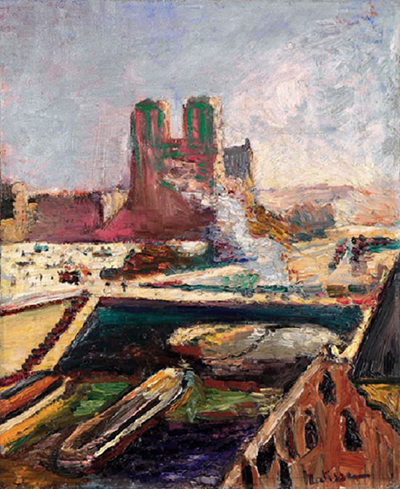Notre Dame is an oil-on-canvas landscape painting, executed in 1900, of a medieval cathedral that resides on the banks of the River Seine. The west façade of the Notre-Dame de Paris, with its distinctive twin towers, was visible from the window of Matisse's riverside studio and the French artist created several landscape paintings of the river as well as of the cathedral.
A barge, moving towards the religious building, is about to pass under one of the thirty-seven bridges that were built across the Seine while another vessel is moored nearby. The painting, measuring 460 mm by 375 mm, is exhibited at the Tate St Ives which acquired the artwork in 1949.
It is evident, from the blue sky and the use of warm colours, that Matisse executed the painting during the summer when the sunlight is at its most intense. There are few shadows in the painting and the bridge, in the foreground of the painting, is one of the few structures that provides some shade. The west façade of the cathedral, devoid of intricate details, is comprised of different hues of salmon while the rectangular towers are edged with a dark green that streaks downwards into the main body of the building. A mixture of blues, browns, greens, oranges, purples and reds can be found in the river which is grey and white-flecked beyond the bridge.
The Seine, the river on which Paris was founded, is an important commercial waterway and levels of traffic increased after France transitioned from an agricultural society into an industrial society. Themes of industrialization, represented in the form of the riverboat that moves along an engineered stretch of the river, are present in this painting. It could be argued that cities, since the inception of the first urban environments in ancient times, had always stood in stark contrast to the natural world but Matisse's inclusion of the barge on the Seine juxtaposes the medieval cityscape with the everyday realities of life in an industrialized urban environment.
River transport, before fuel-burning engines were used to power merchant vessels in the nineteenth century, had been towed from the land or punted via the use of poles while masts and sails were more practical for use at sea where the winds were more powerful and where there were fewer obstacles such as bridges. The typical barge in use on the Seine at the turn of the twentieth century, such as that present in the painting, was propelled by a screw that was powered by an onboard diesel engine.




